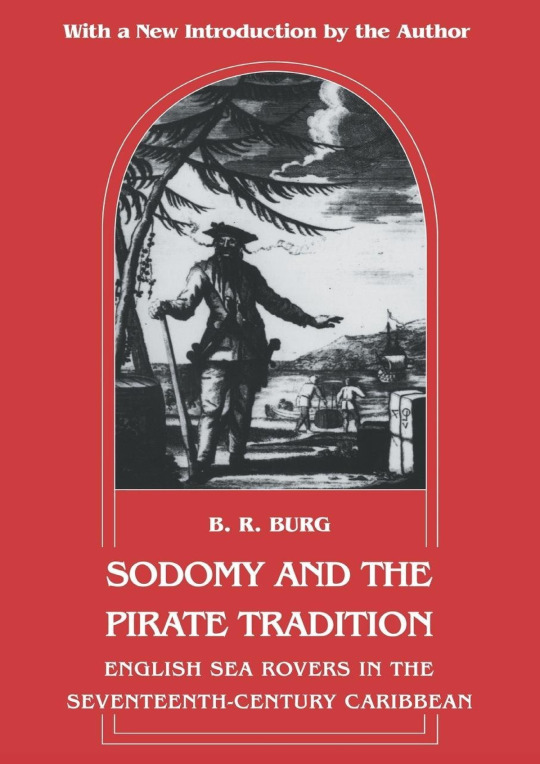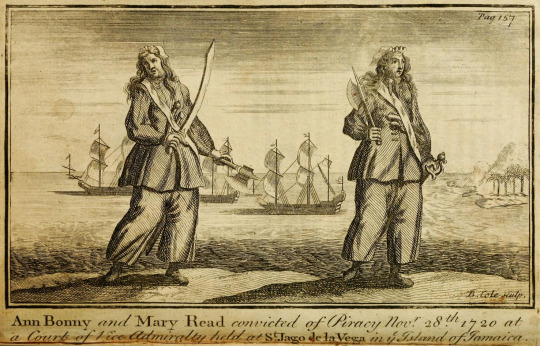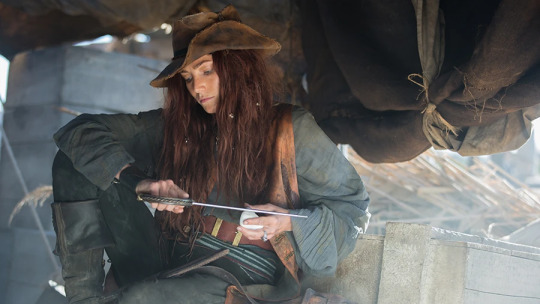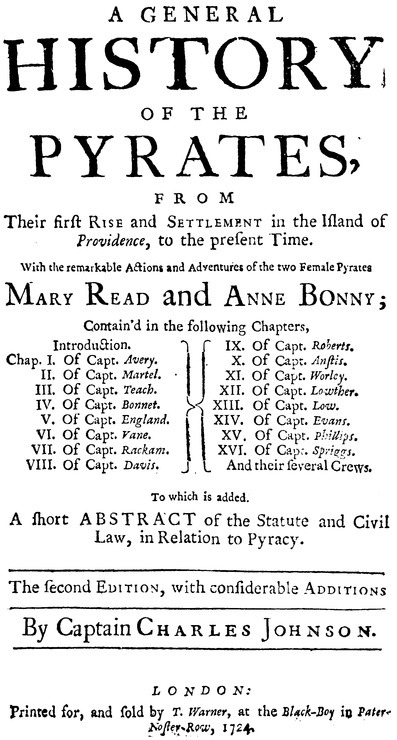#historical piracy
Text
BLOG INTRODUCTION
Hello tumblr! You may call me Roger. I’m English/Scottish and a slight autist. Also, I am queer, because apparently tumblr people like to know that. I have been into pirate history for many years. I would like to start this off by saying I am NOT A QUALIFIED HISTORIAN OR EXPERT. This blog will be well researched and I will do my best to use reliable sources (and list them), but do not use this blog itself as a source. My posts exist to encourage you to read further into sources.
Now, as the blog description states, I am going to be posting pirate facts and discussing pirate myths. I will also occasionally post about and discuss fictional pirate media. Some topics I plan to discuss when this blog is started include:
•Matelotage & the treatment of queers by pirates and sailors in history
•Was Stede Bonnet REALLY that bad?
•Why Jack Rackham and Bartholomew Roberts are criminally overrated
•Food eaten onboard of a ship- why hardtack?
•Did they really have parrots? What about other pets?
•Barber-Surgeons, because I never see them talked about
•A General History Of The Pyrates: the biggest piece of 18th century clickbait to ever be written
•Libertalia, Captain James Mission and other hilarious and blatant lies
If you are into piracy or looking to get into its history, please give me a follow! A like or reblog to help get this blog out there would also be very helpful. :] liking my posts also let’s me know that there is an interest for history on this site
#ofmd#our flag means death#potc#pirates of the caribbean#black sails#pirates#piracy#golden age of piracy#historical piracy#historical pirates#Blackbeard#Edward teach#Stede bonnet#anne bonny#Mary read#black flag#assassins creed black flag#assassins creed 4#the pirates! band of misfits
15 notes
·
View notes
Text
(Spoilers for OFMD ahead) Our Flag Means Death may not be historically accurate all the time (by this I mean Blackbeard in leather and crop tops but we are absolutely here for it), but it’s one of the most historically accurate depictions of piracy that I’ve ever seen.
Like for example in the episode where Stede gets the map and is looking for buried treasure, and Edward points out that absolutely no one does that. Because very few pirates actually buried any treasure.
And when Black Pete is talking about how Blackbeards face was smoke in episode 1 I think? One of historical Blackbeards main intimidation tactics was to light his beard on fire to make it all smokey. He also historically avoided directly killing people, much like what is portrayed in the show.
Also most shows and movies about piracy glamorize it and make it seem like a bunch of guys who just sail around a bit, but Our Flag Means Death shows the more violent aspects (like for instance, when Ed cut off Izzy’s toe and force fed it to him) and gives us morally flawed characters, which is so great and refreshing in pirate themed media.
My point is, it’s historically accurate enough in the places that matter to make it all around a great show to watch, and it has great representation. Like they did way more than the bare minimum, and still made it a really cool show, with an amazing plot, and really interesting and complex characters. It’s great. Our Flag Means Death is the best.
160 notes
·
View notes
Text
i do think izzy's "the only retirement we get is death" line is so funny because like the thing he's most famous for is being a b list villain in one of the most popular children's books of all time where he gets killed by a preteen. so like yes, the only retirement in store for him is death, but on the other hand, he can never actually die (or never stop dying depending on how you look at it) because he's been immortalized in one of the most well known and most adaptated fictional works of all time
#so like watch out i guess!!!#you can achieve immortality. but watch out!!!#izzy hands#ofmd#our flag means death#treasure island#israel hands#you cannot divorce the character or historical figure of israel hands in any of his iterations from the character israel hands in treasure#island sorry#it's all about treasure island#which isnt to say the other irl pirates havent been immortalized in works of fiction or even the mythology surround pirates and piracy from#the golden era but like thats just not the same as being in mother fucking treasure island
104 notes
·
View notes
Photo

Medes islets in front of the coast of L’Estartit (Comarques Gironines, Catalonia).
According to the legend, the famous pirate Barbarossa (Khair ed-Din) died in this islets after being chased by the Pope’s float. When the Pope’s men captured him, they killed him and threw his body overboard. For this reason, Barbarossa’s body rests eternally under these waters and, depending on the angle that the sun’s rays hit the water, you can see a shine: Barbarossa’s saber 🗡️.
(In reality, Barbarossa died in Constantinoble and is buried there.)
#llegendes#illes medes#l'estartit#catalunya#barbarossa#pirates#piracy#mediterranean#sea#historical#history#island#islands#myths and legends#catalan folklore#cultures#age of sail#myth#legends#mythology#mythology and folklore
46 notes
·
View notes
Text

Thoughts on B.R. Burg's Sodomy And The Pirate Tradition:
All right, this isn't going to be a big, put-together essay, just scattered thoughts, since that's what I'm capable of right now.
This book and its writer are real "queer studies" OGs, and its attitude is very much of that initial post-Stonewall, pre-AIDS gay liberation era. It's a book with attitude and confidence, and with the historical facts to back it up. For an academic text (a style of writing I never got along well with), it's a very fun read.
On to the fun facts!
In spite of how common tavern wenches and dockside whores are as characters in pirate fiction, there was only one brothel in Port Royal in 1680! (This is less surprising than it sounds—with the exception of religious freedom colonies like Maryland and Massachusetts Bay, Britain's American colonies during this era had male:female ratios averaging between 5:1 and 2:1, and the women of the colonies tended to be the wives of male colonists.)
If you spend a certain amount of time in Age of Sail/pirate fandoms, you will come across the idea that pirates had a rule or tradition against oral sex. While it's true that all the written records we have of shipboard sodomy at this point in history are about hand stuff or penetration, Burg argues sensibly that this was less due to any formal prohibitions, and more due to the general unwashedness of Age of Sail seamen. (Which... fair.)
While the pirate institution of matelotage gets talked about online as something like "pirate gay marriage", Burg makes it sound like something closer to pirate indentured servitude. However, he does give examples of matelots and their masters who did become uncommonly close and emotionally bonded, and does mention "pirate marriage" as a separate thing that also happened.
From the less-distant past, it was interesting to see which of the stereotypes about queer men that existed at the time of writing were seen as necessary to debunk, both in relation to pirate society and in relation to contemporary gay subculture—namely, the perceived prevalence of sadomasochism and of effeminacy among queer men.
These were some of the things I found most interesting about the book, but there's plenty more I'd like to talk about it with other people who are either curious about it or who have read it. Let me know you thoughts!
#sodomy and the pirate tradition#pirates#pirate#piracy#golden age of piracy#age of sail#queer studies#queer history#historical pirates#lgbt history#lgbtq history#gay history#gay pirates#our flag means death#black sails#one piece
44 notes
·
View notes
Text
History Memes #7

If anyone is confused about the part that is a different font, it’s probably because the original creator didn’t note that while Huseyin is Algerian, he was a Pasha for the Ottoman Empire, which Algeria was a vassal state of.
#funny humor#funny memes#history memes#history#ottoman#ottoman empire#algeria#france#historic anecdotes#dark humor#funny#Barbary coast#piracy#pasha#1600s#1600s art#doge
48 notes
·
View notes
Text
i often do forgot and am subsequently struck by the fact that Stede Bonnet and Edward Teach were like. Real historical people
and now when you google them the first thing that comes up is a show that’s essentially a fanfiction of them falling in love. that’s their legacy now.
the historical Stede and Edward would probably fucking hate that and honestly that makes it so much better
#like that’s so funny#you spend your entire life trying to make a name for yourself in piracy#and three hundred years after you die queer people online are calling you babygirl#imagine explaining the izcourse to the historical Israel Hands. like#our flag means death#ofmd#text#mine
42 notes
·
View notes
Text
no because i'm over here trying to maintain a steady course and trying to not jump to conclusions and trying not to panic over out of context articles/questions/pieces of texts where i can't properly read the tone
and then rhys rolls up with-


#LIKE????#HELLO???????#i'm so#like i was kicking my legs and giggling all the way through that entire article#because it was so nice to see him so excited about getting to be a mermaid#and so so nice to finally hear him talk#AND THEN THAT JUST#WAS A SUCKER PUNCH STRAIGHT TO THE JUGULAR RIGHT THERE AT THE END?????#but like#i feel like david wouldn't........right?#RIGHT???????#*stede voice* jodi you're panicking!#*Ed voice* I'M NOT PANICKING ALRIGHT#y'all know that one spongebob gif where he's just looking forlorn at a table#that's me right now PFFFFF#like many thoughts head full but none of them are Forming Into A Fully Coherent Piece#something something piracy did end up getting killed off by the british indeed#and something something that violence is realistically going to be a threat for them#but also something something these pirates wear crocs and say 'for the lols' and bowl with british soldiers like it's nothing#so i would be SHOCKED if they did indeed get an unhappier more historically accurate fate#idk what's everyone thinking lol HOW ARE WE FEELING#BESTIES/ANONS PSSSPSPSPSPSP#OFMD#OFMD Season 3#Rhys Darby#Gentlebeard#Blackbonnet
23 notes
·
View notes
Note
psst hannibal is on tubi if u wanna stream it conveniently. I do love piracy but I love tubi more (free + unlimited + no account required + they dont seem to care if u use adblockers)
oh hell yeah im saved
#i DO. need to get better at piracy#but of course our ISP is kinda on our asses about it historically#they hate to see a bad bitch watch a little ted lasso😮💨
12 notes
·
View notes
Text
"Legends are as real as the people who created them. They are stories living as truths in people’s minds, but they serve their own selfish purposes. They only see what they want to see." - Lem Finney, Our Legend Lies With You
April 28, 1721 ~

303 years ago today, a woman was buried in St. Catherine's Parish in St. Jago de la Vega "Spanish Town", Jamaica under the name Mary Read with only one word to describe her life: pirate.

The names Mary Read and Anne Bonny may be familiar to you. They've become a popular subject in historical fiction about piracy, such as Assassin's Creed: Black Flag and Black Sails and Our Flag Means Death (my personal favorite).



Their names have become associated with fierce female pirates who plundered the seas, terrified men, and objected to the conforming roles for women in early 18th century colonial life.
However, those are just legends, embellished over time. What do we even really know about these women?

On May 14, 1724, a book was published under the pseudonym "Captain Charles Johnson" which became known as A General History of the Pyrates. In it details the true, factual lives of names that would become synonymous with the Golden Age of Piracy: Blackbeard, Calico Jack, Black Bart, even coining the famous Jolly Roger. Mary Read and Anne Bonny especially were a huge selling point among the 18th century English aristocracy, as they still are today. Men becoming pirates was believable enough; a violent environment full of greed and disrespect for 'good-natured' society. But two women? It shocked and intrigued audiences alike, and it sold like mad.
These stories defined the perspectives of generations, serving as inspiration from Treasure Island to The Pirates of the Caribbean. With such outlandish, captivating tales of debauchery and misdeeds, it was almost too good to be true!
And it was too good to be true; without so much as a single source beyond trial records, Captain Charles Johnson completely falsified the lives of these pirates into spectacles to feed into the prejudices and perverted fascinations of the white, misogynist, heterosexual, English elite.
Anne Bonny and Mary Read were embellished the most. Petty excuses were made to justify their crossdressing; romantic male interests became the center of their heroism (while sapphic deviations were teased at); bearing their breasts in battle became a bodily chain to their inescapable female fate; they were turned into murderous warriors despite never being charged with murder and only being on the high seas for two months. They were no longer human; they were legends.
So, on April 28, 2023, I wrote a story and called it Our Legend Lies With You. In it, I reimagined the lives of Anne Bonny and Mary Read as Ann Fulford and Maura Reed. I used dates and accounts of witnesses from the original court documents of Anne and Mary's trial to frame their experiences. The rest is a fictitious account to show you what could have happened.
The novella will be self-published by me, Lem Finney, on May 14, 2024 on Amazon, to mark the 300th anniversary of The General History's original publication. 300 years later, I hope I can provide readers with a different way of looking at history by reimagining the voices of people who have been erased and rewritten. It may not be entirely true, but I believe there is truth in it.
"When there are enough people sharing a collective conscience, when history has sided one way and left the other to dust, what voice remains whole and intact and unwavering amidst the sea of the mob to say it isn’t true?" - Lem Finney, Our Legend Lies With You
#ollwy#anne bonny#mary read#writing#writblr#books#writers on tumblr#our flag means death#ofmd#assassin's creed#black sails#pirates#piracy#historical fiction#fiction#gay#queer#lgbt#lgbtq#queer fiction#bookblr#booklr#history#internalized homophobia#friends to lovers#french#angst#hurt/comfort#i love piracy#pirate
10 notes
·
View notes
Text
actually it's too bad they killed off izzy before the "what kind of fucking idiot runs his ship aground" joke could come to fruition (the historical israel hands ran his ship aground while trying to help historical blackbeard, who had also run his ship aground)
#funnily enough izzy has arguably been the least historical character considering the real hands took the pardon#and presumably did not die from piracy#anyways rip to the joke potential#ofmd
20 notes
·
View notes
Text

why is half this cast so painfully british, like PAINFULLY british (and I say this as an immigrant living over here x'D)
#one piece#one piece spoilers#also thank you for finally explaining wtf devil fruits are will you tell us the no swimming cause the ocean hates you thing next#look lOOK I can get behind the like- logic I guess of going off historical piracy where a lot of the white ppl were from the UK#but there were ones from like france and iberia and stuff too!#gimme some french ppl or some danes#or at least some more non-posh/english british ppl
28 notes
·
View notes
Text
Retelling of overused historical periods (part 1)
There are some historical periods that are so much used in stories to become boring, like, there's no more something interesting about them, right?
Wrong
Lucky (or unfortunately, depends on the point of view) stories tend to focus only on some aspects of history, leaving out all the rest.
But "the rest" is so fascinating!
Here are some prompts on how you can make overused historical times interesting again.
Ancient Rome
Especially last years of Republican period and first century of Imperial period
Tell the stories of women. This is going to be a recurrent advice but here I mean it with all my heart: talk about women, properly. Roman women between I century bc and II century ad had to face a lot and did it with great force and pride: they fought to be educated (and some of them started to work in law), some of them became writers (often uncredited, like Sulpicia), they had to face a law that punished sexual behavior outside of marriage (even for unmarried girls) and fought against them united, they obtained divorce (and divorced women started to be common after I century bc) and in imperial periods they obtained more civil rights. Some historians say that what they did was a feminist movement ante litteram. If you want a nice reality based prompt: when Augustus imposed a law stating that every woman (married and unmarried) that had sex with a person that wasn't her husband would be punished- apart from prostitutes, lots aristocrat women decided to go all together to sing up as prostitutes (even if they weren't) as a protest. They won.
Greek slaves. Romans had different levels of slavery and usually slaves from Greece were classified familia urbana: they had to work in the family of their owner/patron but had greater respect than other kind of slaves. They had to manage the family patrimony, educate the young members of the family (greek culture was fashionable) and help their patron at work. Usually after years of work they became libertus: freed people.
People who decided to put otium (making of art, literature, poetry and philosophy) before negotium (working in law or in commerce). It wasn't a lot encouraged and young people who did so were the "wasted youth" or the unproductive. Culture was seen as good only if it had a second mean like propaganda. Art for art's sake wasn't acceptable, and lots of young people fought for that. If you want a reality based prompt: Catullus and neoteros.
Bisexuality. Lots of historical fictions forget how much bisexuality was common in ancient rome. It wasn't seen as completely good (there were a lot of prejudices) but many of important figures were bisexuals (I'm looking at you, Cesar). Take this as an invite to make queer representation.
Victorian London
Talk about women (this is going to be a leitmotiv) in a different way. On one hand we have the Victorian idea of women (very oppressive) and on the other we have the rise of feminism with its different ramifications. Highlight this opposition and talk about women who had the courage to stand out.
Poor people and working class. Usually Victorian based fiction is about aristocrats or rich borgueis class but poor people had a more interesting story: the protests, police brutality, the rising of socialism, strikes, the first trade unions and the fight to make them legal, chartism and other attempts to be important in politics.
Queer people. Homosexuality (and other queer identities) was forbidden and punished with prison. Still, queer culture in the Victorian England is huge. This aspect can't go forgotten in history and fiction.
Immigrants. According to Wikipedia
there were about 2 339 000 immigrants in Victorian Britain, mostly from Ireland, Belgium, Germany and lots of them were Jews, but there were lots of immigrants from South Asia, China, the African continent and West India too. Telling their stories would be original and much needed.
The Golden Age of Piracy
You know what I'm going to suggest, right? Women! Yeah you saw it coming. Women pirates were a thing and we need to talk about them more often. Lots of them used male names and identities in order to be safe and revealed themselves only later (and often when killing their enemies as a way to state "you've been defeated by a woman, you sexist idiot") . Sometimes they were desperate and looking for a way of surviving that wasn't prostitution but I really hope that their story won't be only filled with trauma and suffering: they were badass, powerful and free. Celebrate them. Anyway, some of them could have been transmen and transmasc people and it's really important to not put a cisheteronormative gaze on them. Queer and trans pirates were a thing as well as women pirates.
Matelogate and queerness in pirates. Matelogate was similar to modern civil unions and stipulated between men: they promised to share everything and had legal (in the law pirates recognized) protection as a couple, and benefits too. Matelogate wasn't exclusively an agreement between lovers but it has been reported that almost all pirates who decided to matelogate had a romantic and/or sexual bond with the people they decided to commit to. I'm saying people because apparently (I still have to do deep researches about it) polyamorous pirates were a thing too.
Black pirates. Seriously, lots of people think that pirates were only white but actually there were plenty of nonwhite pirates and especially black pirates. Usually they chose piracy as a way to escape slavery but as I said with women pirates before: even of history is filled with pain, try to not focus only on trauma and portrait your characters in a non triggering way. Empower them as a way of giving them the justice history denied.
As you can see in this first part of my "retelling history posts" acknowledging parts of history that have been erased in mainstream storytellings is a powerful tool for creativity but it's especially a way of protecting part of history from the process of erasing who didn't have privileges.
#story prompt#writing#writing prompt#prompts#historical periods#historical fiction#history#historical prompts#women in history#queer history#black history#immigrant history#ancient rome#victorian london#19th century#piracy#golden age of piracy#queer pirates#women pirates#black pirates#roman literature#retelling history#history facts#feminism
306 notes
·
View notes
Text
i think what doesn't work for me when people talk about tsv supposedly being religious horror/making commentary about "religion" as a broad overarching category is that it's nonsensical to make commentary about "religion" in general. you can't do it. you have to pick one, and if you pick one it's going to show like black lettering under a thin layer of white paint. tsv borrows terminology, sure, it has its saints and angels--but they're deeply alien to saints and angels as they are understood in real world traditions. re-skinned catholicism this ain't
like this is what i mean when i say i don't think of tsv as being about its religions, but that it uses them as a vehicle to talk about (state/corporate/individual) power and violence. we see those themes of zealotry and clerical power struggles, but they aren't what the story's about. a story that is "about religion" isn't going to hand you catering staff being sacrificed to a fossil fuel god or incarcerated people being turned into public infrastructure.
and i don't think tsv would have the appeal that it does if it were about a specific kind of religion in that narrow way. because it's talking about these systems of power and violence that are very real, just made fantastical by the setting, it's much more biting than if it were trying to focus on religion. because tsv's gods and religions are strange and alien, the audience is able to sidestep a lot about real world traditions and engage more with the other themes, in a way that would be impossible if you scratched the surface and found "western christianity but weirder" under the paint.
#that's just like my opinion tho#obviously none of this precludes finding resonance between certain elements of tsv's fictional religions and real world traditions#but i really resist the idea that tsv is 'about' religion bc religion is the vehicle#and the thing that creates the heightened and fantastical elements of the world#in the way that black s4ils isn't really about the historical conditions that created golden age piracy#hard pressed to think of another example bc the cats woke me up at 4am and i've been working on this post for like 40 min#trying to be precise and clear about what i mean#anyway my point is in tsv religion is the paint not the picture#imo.#tsv tag#like having intentionally done western christianity re-skinned for story settings#i feel i know of what i speak
17 notes
·
View notes
Text
Ann Bonny and Mary Read.
Below is a screenshot of a portion of the actual trial record for Ann* Bonny and Mary Read, the two most famous female pirates in history. This is the most detailed eyewitness description of them known to survive to the present day.

Image: Screenshot of an excerpt from the trial record of pirates Ann Bonny and Mary Read.
Here is the text with some edits on my part to update anachronistic spelling and grammar, for those who don't want to try to parse early 18th century court documents:
"Dorothy Thomas deposed, that she, being in a canoa at sea, with some stock and provisions, at the North-side of Jamaica, was taken by a sloop, commanded by one Captain Rackam (as she afterwards heard;) who took out of the canoe, most of the things that were in her: and further said, that the two women, prisoners at the bar, were then on board the said sloop, and wore mens jackets, and long trousers, and handkerchiefs tied about their heads; and that each of them had a machet and pistol in their hands, and cursed and swore at the men, to murder the deponent; and that they should kill her, to prevent her coming against them; and the deponent further said, that the reason of her knowing and believing them to be women then was, by the largeness of their breasts."
Source: https://www.postandcourier.com/the-tryals-of-captain-john-rackam-and-other-pirates/pdf_68970990-ded9-11e8-be44-1b1f2868c03d.html
*And yes, its often spelled "Ann" with no e in contemporary documents- the e appears to have been an error in the trial record which stuck. Ann also seems to have used aliases, and is sometimes referred to in contemporary sources by the last name Bonn or Fulford, or the first name Sarah, leaving some ambiguity as to her real name.
#Ann Bonny#Anne Bonny#Mary Read#Pirates#Piracy#John Rackham#Jack Rackham#John Rackam#Calico Jack#Historical documents#Primary sources#Women Pirates
6 notes
·
View notes
Text
I'm nearly finished reading Sodomy and the Pirate Tradition, are people interested in my thoughts/some fun facts once I'm through with it?
#sodomy and the pirate tradition#b.r. burg#queer studies#golden age of piracy#age of sail#pirates#historical pirates#pirate history#maritime history#maritime#nautical#piratecore#do i dare tag#ofmd#our flag means death#black sails
13 notes
·
View notes